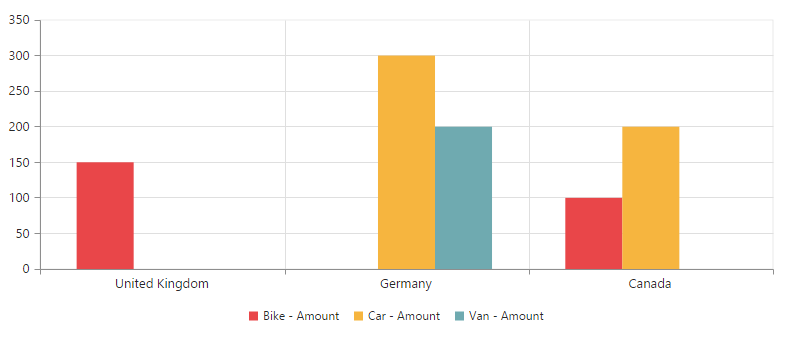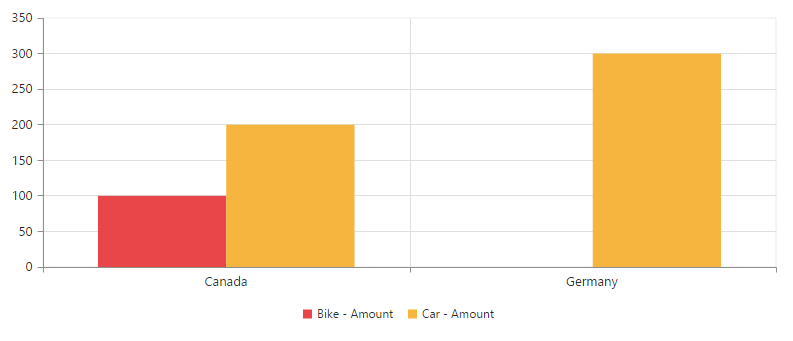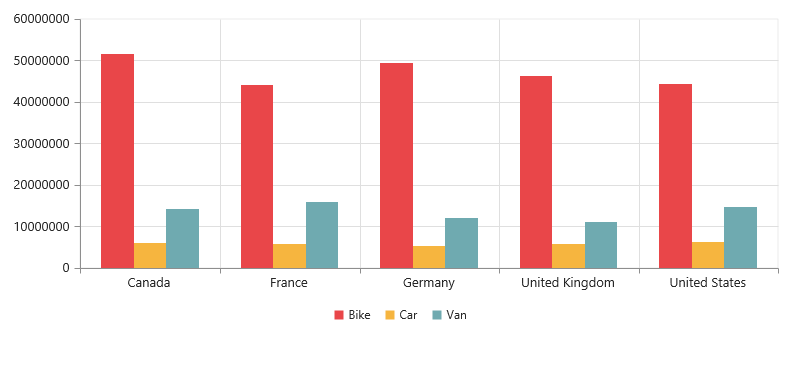Getting started with JavaScript PivotChart
3 May 202124 minutes to read
Creating a simple application with pivot chart and relational data source (client mode)
This section covers the basic information required to populate a simple pivot chart with relational data completely on the client-side.
Scripts and CSS references
Create an HTML page and add scripts and style sheets that are required to render a pivot chart widget which are highlighted below in an appropriate order:
- ej.web.all.min.css
- jQuery-3.0.0.min.js
- ej.web.all.min.js
Initialize pivot chart
Place a “div” tag in the HTML page which acts as a container for the pivot chart widget. Then, initialize the widget by using the “ejPivotChart” method.
<!DOCTYPE html>
<html>
<head>
<title>PivotChart - Getting Started</title>
<link href="http://cdn.syncfusion.com/32.1.19/js/web/flat-azure/ej.web.all.min.css" rel="stylesheet" type="text/css" />
<script src="http://cdn.syncfusion.com/js/assets/external/jquery-3.0.0.min.js" type="text/javascript"></script>
<script src="http://cdn.syncfusion.com/32.1.19/js/web/ej.web.all.min.js" type="text/javascript"></script>
</head>
<body>
<!--Create a tag which acts as a container for ejPivotChart widget.-->
<div id="PivotChart1" style="width: 800px; height: 350px"></div>
<script type="text/javascript">
$(function () {
//Initialize ejPivotChart widget.
$("#PivotChart1").ejPivotChart();
});
</script>
</body>
</html>Populate pivot chart with data
This section illustrates how to populate the pivot chart control using a sample JSON data as shown below:
var pivotData = [
{ Amount: 100, Country: "Canada", Product: "Bike" },
{ Amount: 200, Country: "Germany", Product: "Van" },
{ Amount: 300, Country: "Germany", Product: "Car" },
{ Amount: 150, Country: "United Kingdom", Product: "Bike" },
{ Amount: 200, Country: "Canada", Product: "Car" }
];Now, set the JSON data to the “data” property available in the “dataSource” object. The “dataSource” object allows you to set the raw data input and the fields that should be displayed in the row, column, value, and filter section of the pivot chart control.
<!DOCTYPE html>
<html>
//....
<body>
<div id="PivotChart1" style="width: 800px; height: 350px"></div>
<script type="text/javascript">
//Datasource
var pivotData = [
{ Amount: 100, Country: "Canada", Product: "Bike" },
{ Amount: 200, Country: "Germany", Product: "Van" },
{ Amount: 300, Country: "Germany", Product: "Car" },
{ Amount: 150, Country: "United Kingdom", Product: "Bike" },
{ Amount: 200, Country: "Canada", Product: "Car" }
]
$(function () {
$("#PivotChart1").ejPivotChart({
dataSource: {
//Datasource bound to pivot chart control.
data: pivotData,
//Required fields in row, column, value and filter areas of pivot chart control.
rows: [
{
fieldName: "Country",
fieldCaption: "Country"
}
],
columns: [
{
fieldName: "Product",
fieldCaption: "Product"
}
],
values: [
{
fieldName: "Amount",
fieldCaption: "Amount"
}
],
},
size: {
height: "350px",
width: "800px"
}
});
});
</script>
</body>
</html>The above code will generate a simple pivot chart with sales amount over a range of products across different locations.

The following table will explain the relational datasource properties at client-side in detail:
| Properties | Description | ||||||||||||||||
|---|---|---|---|---|---|---|---|---|---|---|---|---|---|---|---|---|---|
Lists out the items to be arranged in the columns section of the PivotGrid.
|
|||||||||||||||||
Lists out the items to be arranged in the rows section of the PivotGrid.
|
|||||||||||||||||
Lists out the items that support calculation in the PivotGrid.
|
|||||||||||||||||
Lists out the items which supports filtering of values without displaying the members in UI of the PivotGrid.
|
Apply sorting
You can sort a field either in ascending or descending order by using the “sortOrder” property. The sorting is applicable only for the fields in rows and columns.
You can sort a field either in ascending or descending order by using the “sortOrder” property. Sorting is applicable only for fields in rows and columns.
NOTE
By default, the values in all fields are arranged in ascending order.
$(function () {
$("#PivotChart1").ejPivotChart({
dataSource: {
//....
rows: [
{
fieldName: "Country",
fieldCaption: "Country",
sortOrder: ej.PivotAnalysis.SortOrder.Descending
}
],
//....
},
});
});
Apply filtering
The filtering option allows you to show or hide a set of values. The filtering option is applicable only for the row, column, and filter areas.
“filterItems” object allows you to apply filtering to fields by using the following properties:
- filterType - indicates whether the values should be included or excluded.
- values - specify an array of values that need to be included or excluded within the particular field.
$(function () {
$("#PivotChart1").ejPivotChart({
dataSource: {
data: pivotData,
rows: [
{
fieldName: "Country",
fieldCaption: "Country",
filterItems: {
filterType: ej.PivotAnalysis.FilterType.Exclude,
values: ["United Kingdom"]
}
}
],
columns: [
{
fieldName: "Product",
fieldCaption: "Product",
filterItems: {
filterType: ej.PivotAnalysis.FilterType.Include,
values: ["Bike", "Car"]
}
}
],
//....
},
});
});
Creating a simple application with pivot chart and relational data source (server mode)
This section covers the information required to create a simple pivot chart bound with Relational data source from the server-side.
NOTE
This section illustrates creating a simple web application through the Visual Studio IDE since the pivot chart in server mode requires .NET dependency. The web application contains an HTML page and a service that transfers data to server-side, processes, and returns back the data to the client-side for control rendering. The service utilized for communication can be either a WebAPI controller class or a WCF service based on user requirement. Here, both are illustrated for user convenience.
Project initialization
Create a new ASP.NET Empty Web Application by using the Visual Studio IDE and name the project as “PivotChartDemo.”
Next, you can add an HTML page. To add an HTML page in your web application, right-click the project in the solution explorer and select Add > New Item. In the Add New Item window, select HTML Page and name it “GettingStarted.html”, and then click Add.
Now, you can set the “GettingStarted.html” page as start-up page. To do so, right-click the “GettingStarted.html” page and select “Set As Start Page”.
Scripts and CSS initialization
The scripts and style sheets that are required to render a pivot chart widget inside an HTML page that are highlighted below in an appropriate order:
- ej.web.all.min.css
- jQuery-3.0.0.min.js
- ej.web.all.min.js
The scripts and style sheets listed above can be found in any of the following locations:
Local disk: Click here to know more about script and style sheets installed on the local machine.
CDN link: Click here to know more about script and style sheets available in online.
NuGet package: Click here to know more about script and style sheets available in the NuGet package.
Control initialization
To initialize a pivot chart widget, first you can define a “div” tag with an appropriate “id” attribute which acts as a container for the pivot chart widget. Then, you can initialize the widget by using the ejPivotChart method.
<!DOCTYPE html>
<html xmlns="http://www.w3.org/1999/xhtml">
<head>
<title>PivotChart - Getting Started</title>
<link href="http://cdn.syncfusion.com/32.1.19/js/web/flat-azure/ej.web.all.min.css" rel="stylesheet" type="text/css" />
<script src="http://cdn.syncfusion.com/js/assets/external/jquery-3.0.0.min.js" type="text/javascript"></script>
<script src="http://cdn.syncfusion.com/32.1.19/js/web/ej.web.all.min.js" type="text/javascript"></script>
</head>
<body>
<!--Create a tag which acts as a container for ejPivotChart widget.-->
<div id="PivotChart1" style="width: 800px; height: 350px"> </div>
<script type="text/javascript">
//Set properties and initialize ejPivotChart widget.
$(function() {
$("#PivotChart1").ejPivotChart({
url: "/Relational",
size: {
height: "350px",
width: "800px"
}
});
});
</script>
</body>
</html>The url property in the pivot chart widget points the service endpoint, where the data is processed and fetched in the form of JSON. The services used for the pivot chart widget as endpoint are WebAPI and WCF.
NOTE
The above “GettingStarted.html” contains WebAPI URL, which is “/Relational”. If you are using the WCF service, then the URL will look like “/RelationalService.svc”.
WebAPI
Adding a WebAPI controller
To add a WebAPI controller in your existing web application, right-click the project in the solution explorer and select Add > New Item. In the Add New Item window, select WebAPI Controller Class and name it “RelationalController.cs,” and then click Add.
Now, the WebAPI controller is added to your application, which, in-turn, comprises the following file. The utilization of this file will be explained in the immediate sections.
- RelationalController.cs
NOTE
While adding the WebAPI controller class, add the mandatory suffix “Controller”. For example, in the demo, the controller is named as “RelationalController”.
Next, remove all the existing methods such as “Get”, “Post”, “Put”, and “Delete” present in the RelationalController.cs file.
namespace PivotChartDemo
{
public class RelationalController: ApiController
{
}
}List of dependency libraries
Next, you should add the below mentioned dependency libraries to your web application. These libraries can be found in the GAC (Global Assembly Cache).
To add them to your web application, right-click References in the solution explorer and select Add Reference. Now, in the Reference Manager dialog, under Assemblies > Extension, the following Syncfusion libraries are found.
NOTE
If you have installed any version of Essential Studio, then the location of Syncfusion libraries is [system drive:\Program Files (x86)\Syncfusion\Essential Studio\32.1.19\Assemblies].
- Syncfusion.Compression.Base
- Syncfusion.Linq.Base
- Syncfusion.Olap.Base
- Syncfusion.PivotAnalysis.Base
- Syncfusion.XlsIO.Base
- Syncfusion.Pdf.Base
- Syncfusion.DocIO.Base
- Syncfusion.EJ
- Syncfusion.EJ.Web
- Syncfusion.EJ.Export
- Syncfusion.EJ.Pivot
List of namespaces
Following are the list of namespaces to be added on top of the main class in the RelationalController.cs file.
using System.Web.Script.Serialization;
using Syncfusion.JavaScript;
using Syncfusion.PivotAnalysis.Base;
namespace PivotChartDemo
{
public class RelationalController : ApiController
{
}
}Data source initialization
A simple collection is provided as a data source for the pivot chart in this demo section. This data source is placed inside a separate class “ProductSales” in the RelationalController.cs file. Refer to the following code example:
namespace PivotChartDemo
{
//....
//....
internal class ProductSales
{
public string Product { get; set; }
public string Date { get; set; }
public string Country { get; set; }
public string State { get; set; }
public int Quantity { get; set; }
public double Amount { get; set; }
public static ProductSalesCollection GetSalesData()
{
/// Geography
string[] countries = new string[] { "Australia", "Canada", "France", "Germany", "United Kingdom", "United States" };
string[] ausStates = new string[] { "New South Wales", "Queensland", "South Australia", "Tasmania", "Victoria" };
string[] canadaStates = new string[] { "Alberta", "British Columbia", "Brunswick", "Manitoba", "Ontario", "Quebec" };
string[] franceStates = new string[] { "Charente-Maritime", "Essonne", "Garonne (Haute)", "Gers", };
string[] germanyStates = new string[] { "Bayern", "Brandenburg", "Hamburg", "Hessen", "Nordrhein-Westfalen", "Saarland" };
string[] ukStates = new string[] { "England" };
string[] ussStates = new string[] { "New York", "North Carolina", "Alabama", "California", "Colorado", "New Mexico", "South Carolina" };
/// Time
string[] dates = new string[] { "FY 2005", "FY 2006", "FY 2007", "FY 2008", "FY 2009" };
/// Products
string[] products = new string[] { "Bike", "Van", "Car" };
Random r = new Random(123345345);
int numberOfRecords = 2000;
ProductSalesCollection listOfProductSales = new ProductSalesCollection();
for (int i = 0; i < numberOfRecords; i++)
{
ProductSales sales = new ProductSales();
sales.Country = countries[r.Next(1, countries.GetLength(0))];
sales.Quantity = r.Next(1, 12);
/// 1 percent discount for 1 quantity
double discount = (30000 * sales.Quantity) * (double.Parse(sales.Quantity.ToString()) / 100);
sales.Amount = (30000 * sales.Quantity) - discount;
sales.Date = dates[r.Next(r.Next(dates.GetLength(0) + 1))];
sales.Product = products[r.Next(r.Next(products.GetLength(0) + 1))];
switch (sales.Product)
{
case "Car":
{
sales.Date = "FY 2005";
break;
}
}
switch (sales.Country)
{
case "Australia":
{
sales.State = ausStates[r.Next(ausStates.GetLength(0))];
break;
}
case "Canada":
{
sales.State = canadaStates[r.Next(canadaStates.GetLength(0))];
break;
}
case "France":
{
sales.State = franceStates[r.Next(franceStates.GetLength(0))];
break;
}
case "Germany":
{
sales.State = germanyStates[r.Next(germanyStates.GetLength(0))];
break;
}
case "United Kingdom":
{
sales.State = ukStates[r.Next(ukStates.GetLength(0))];
break;
}
case "United States":
{
sales.State = ussStates[r.Next(ussStates.GetLength(0))];
break;
}
}
listOfProductSales.Add(sales);
}
return listOfProductSales;
}
public override string ToString()
{
return string.Format("{0}-{1}-{2}", this.Country, this.State, this.Product);
}
public class ProductSalesCollection : List<ProductSales>
{
}
}
}Service methods in WebAPI controller
Now, you can define the service methods in the RelationalController class, find the RelationalController.cs file which was created while adding the WebAPI controller class to your web application.
namespace PivotChartDemo
{
public class RelationalController : ApiController
{
PivotChart pivotChart = new PivotChart();
JavaScriptSerializer serializer = new JavaScriptSerializer();
[System.Web.Http.ActionName("InitializeChart")]
[System.Web.Http.HttpPost]
public Dictionary<string, object> InitializeChart(Dictionary<string, object> jsonResult)
{
this.BindData();
return pivotChart.GetJsonData(jsonResult["action"].ToString(), ProductSales.GetSalesData());
}
[System.Web.Http.ActionName("DrillChart")]
[System.Web.Http.HttpPost]
public Dictionary<string, object> DrillChart(Dictionary<string, object> jsonResult)
{
this.BindData();
return pivotChart.GetJsonData(jsonResult["action"].ToString(), ProductSales.GetSalesData(), jsonResult["drilledSeries"].ToString());
}
private void BindData()
{
this.pivotChart.PivotEngine.PivotRows.Add(new PivotItem { FieldMappingName = "Country", FieldHeader = "Country", TotalHeader = "Total" });
this.pivotChart.PivotEngine.PivotRows.Add(new PivotItem { FieldMappingName = "State", FieldHeader = "State", TotalHeader = "Total" });
this.pivotChart.PivotEngine.PivotRows.Add(new PivotItem { FieldMappingName = "Date", FieldHeader = "Date", TotalHeader = "Total" });
this.pivotChart.PivotEngine.PivotColumns.Add(new PivotItem { FieldMappingName = "Product", FieldHeader = "Product", TotalHeader = "Total" });
this.pivotChart.PivotEngine.PivotCalculations.Add(new PivotComputationInfo { CalculationName = "Amount", Description = "Amount", FieldHeader = "Amount", FieldName = "Amount", Format = "C", SummaryType = Syncfusion.PivotAnalysis.Base.SummaryType.DoubleTotalSum });
}
}
.....
..... // Datasource initialization
.....
}Configure routing in global application class
To add a Global.asax in your existing web application, right-click the project in the solution explorer and select Add > New item. In the Add New Item window, select Global Application class and name it “Global.asax,” and then click Add.
After adding the Global.asax file, delete all methods in the Global class and add the namespace “using System.Web.Http;”, and then configure the routing as shown in the following code example:
public class Global : System.Web.HttpApplication
{
protected void Application_Start(object sender, EventArgs e)
{
GlobalConfiguration.Configuration.Routes.MapHttpRoute(
name: "DefaultApi",
routeTemplate: "{controller}/{action}/{id}",
defaults: new { id = RouteParameter.Optional });
AppDomain.CurrentDomain.SetData("SQLServerCompactEditionUnderWebHosting", true);
}
}Now, the pivot chart is rendered with sales amount details over a set of products across different countries.

WCF
This section demonstrates the utilization of WCF service as endpoint binding the relational data source to a simple pivot chart. For more details on this topic, click here.